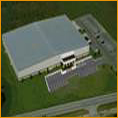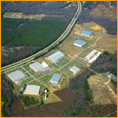Concrete has been around since the Roman Empire. Much of their ancient concrete still survives thousands of years later. One might think there is not much point in trying to improve a time-tested staple like concrete. The Roman formula was actually lost for centuries, and the modern Portland Cement Concrete we use today had its origins in early 1800s England. It has become the number 1 construction material in the world. Lots of people use it in lots of different ways.
Concrete is naturally resistant to crushing; or, in Engineer speak, it has High Compressive Strength. You can order a mix of components to get a wide range of compressive strengths from 1000psi to 6000psi. Even higher strengths can be prepared for special applications. The limiting characteristic of concrete is that it is neither very flexible nor very stretchy. Engineers call this Flexural Strength and Tensile Strength respectively. Historically, steel has been used to give concrete more strength in these categories. It works well and the two materials are compatible. The problem is steel reinforcing requires its own manufacturing timeline in addition to and preceding the actual concrete construction.
Structural Engineers design the reinforcing in a foundation. Then a subcontractor has to prepare shop drawings showing all the lengths of each piece of steel reinforcing, with all the needed bends for it all to go together. That can take up to six weeks. Then, the Structural Engineer reviews those shop drawings which take another couple of weeks. Once the shop drawings are approved, then the steel can be fabricated and delivered to the site taking another few weeks. So, before you can even get started with the foundations (one of the first things needed for building construction), it takes 2-3 months for the steel to arrive on site.
Then, once the steel has arrived, the foundations can be dug and the process of tying the rebar into its designed configuration must be completed; and, the local inspector has to approve it before the actual concrete can be placed. If it rains before the inspector arrives, you get to pull the steel back out of the excavation; dig out the mud; and, put it back in place and have the Inspector return and approve before the concrete can be placed, hopefully all before the next rain.
The new twist is to replace the long lead time of steel reinforcing with small twisted steel wires like Helix Micro-Rebar mixed directly into the concrete in the truck. The supplier designs the appropriate mix to replace the steel bars, and the 3-month lead time is cut to about two weeks. When excavations are opened up for foundations, they can be inspected and immediately have the concrete placed the same day, virtually eliminating the weather risk of traditional steel reinforcing methods. This saves time and risk and provides better-performing concrete. This twist in the road is heading in the right direction!



